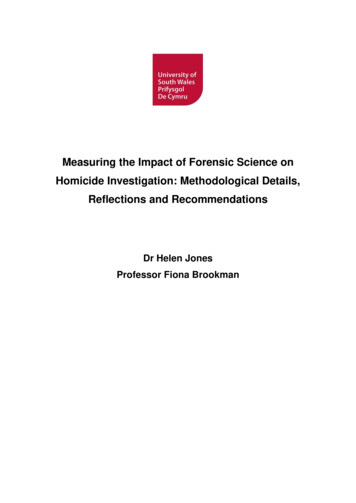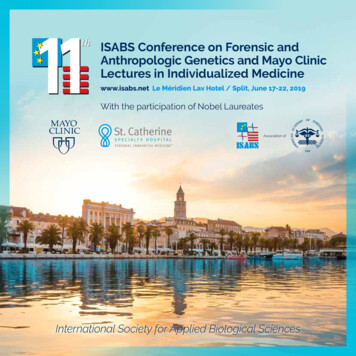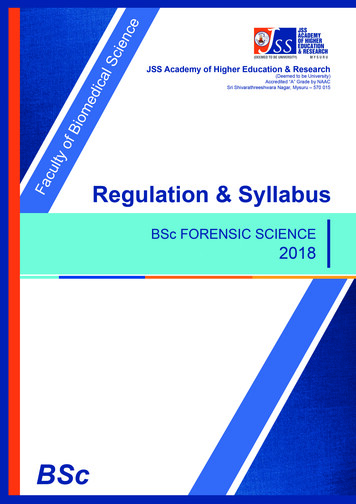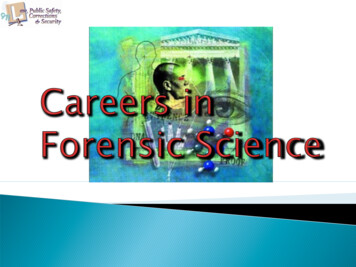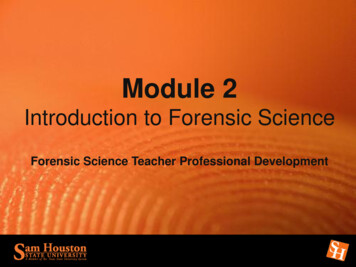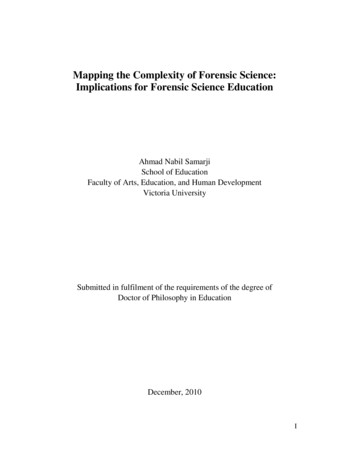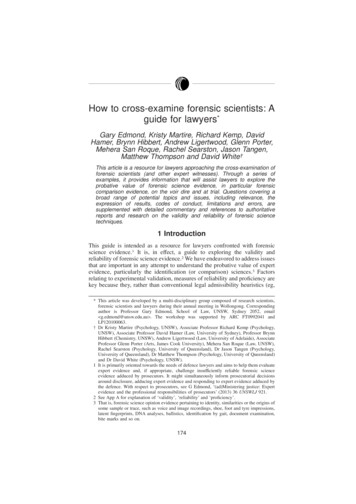
Transcription
JOBNAME: No Job Name PAGE: 68 SESS: 3 OUTPUT: Fri Oct 17 11:26:18 2014/journals/journal/abr/vol39pt2/part 2How to cross-examine forensic scientists: Aguide for lawyers*Gary Edmond, Kristy Martire, Richard Kemp, DavidHamer, Brynn Hibbert, Andrew Ligertwood, Glenn Porter,Mehera San Roque, Rachel Searston, Jason Tangen,Matthew Thompson and David White†This article is a resource for lawyers approaching the cross-examination offorensic scientists (and other expert witnesses). Through a series ofexamples, it provides information that will assist lawyers to explore theprobative value of forensic science evidence, in particular forensiccomparison evidence, on the voir dire and at trial. Questions covering abroad range of potential topics and issues, including relevance, theexpression of results, codes of conduct, limitations and errors, aresupplemented with detailed commentary and references to authoritativereports and research on the validity and reliability of forensic sciencetechniques.1 IntroductionThis guide is intended as a resource for lawyers confronted with forensicscience evidence.1 It is, in effect, a guide to exploring the validity andreliability of forensic science evidence.2 We have endeavored to address issuesthat are important in any attempt to understand the probative value of expertevidence, particularly the identification (or comparison) sciences.3 Factorsrelating to experimental validation, measures of reliability and proficiency arekey because they, rather than conventional legal admissibility heuristics (eg,* This article was developed by a multi-disciplinary group composed of research scientists,forensic scientists and lawyers during their annual meeting in Wollongong. Correspondingauthor is Professor Gary Edmond, School of Law, UNSW, Sydney 2052, email g.edmond@unsw.edu.au . The workshop was supported by ARC FT0992041 andLP120100063.† Dr Kristy Martire (Psychology, UNSW), Associate Professor Richard Kemp (Psychology,UNSW), Associate Professor David Hamer (Law, University of Sydney), Professor BrynnHibbert (Chemistry, UNSW), Andrew Ligertwood (Law, University of Adelaide), AssociateProfessor Glenn Porter (Arts, James Cook University), Mehera San Roque (Law, UNSW),Rachel Searston (Psychology, University of Queensland), Dr Jason Tangen (Psychology,University of Queensland), Dr Matthew Thompson (Psychology, University of Queensland)and Dr David White (Psychology, UNSW).1 It is primarily oriented towards the needs of defence lawyers and aims to help them evaluateexpert evidence and, if appropriate, challenge insufficiently reliable forensic scienceevidence adduced by prosecutors. It might simultaneously inform prosecutorial decisionsaround disclosure, adducing expert evidence and responding to expert evidence adduced bythe defence. With respect to prosecutors, see G Edmond, ‘(ad)Ministering justice: Expertevidence and the professional responsibilities of prosecutors’ (2013) 36 UNSWLJ 921.2 See App A for explanation of ‘validity’, ‘reliability’ and ‘proficiency’.3 That is, forensic science opinion evidence pertaining to identity, similarities or the origins ofsome sample or trace, such as voice and image recordings, shoe, foot and tyre impressions,latent fingerprints, DNA analyses, ballistics, identification by gait, document examination,bite marks and so on.174
JOBNAME: No Job Name PAGE: 69 SESS: 1 OUTPUT: Fri Oct 17 11:26:18 2014/journals/journal/abr/vol39pt2/part 2How to cross-examine forensic scientists: A guide for lawyers175field, qualifications, experience, common knowledge, previous admission,etc), provide information about actual ability and accuracy that enable expertevidence to be rationally evaluated by judges and jurors. The issues canvassedhere are those that authoritative scientific organisations (eg, the US NationalAcademy of Sciences) suggest should be central to any attempt to assess theprobative value of scientific, technical and medical evidence.4This guide was designed to help lawyers as they approach and prepare forcross-examination.5 Cross-examination requires careful attention to the factsin issue in the instant proceedings. In some cases, forensic analysts will makeconcessions; thereby eliminate the need for protracted cross-examination thatmight be onerous and prove difficult for a judge or jury to comprehend, evenwhen conducted in an exemplary fashion. On most occasions however,determining the need for and approach to cross-examination will requireconsiderable effort. Such decisions will generally require independent readingand preparation and very often consultation with relevant experts for adviceand assistance.6 In most cases it will be desirable to meet with the state’sforensic analyst prior to the trial or voir dire. This guide aims to suggestpotentially important lines of inquiry and the kinds of questions that might beput to those claiming expertise when they testify in criminal proceedings. It isdesigned to encourage lawyers to ask questions and engage with issues thatwill usually be important in any attempt to determine relevance, admissibilityand probative value (ie, ‘weight’).7Because responses to questions posed in cross-examination will often markthe limits of the evidence it is vitally important for those questioning ‘experts’to attend very closely to responses.8 Historically, lawyers and courts have4 National Research Council (of the National Academy of Sciences), Strengthening theForensic Sciences in the United States: A Path Forward, Washington DC, The NationalAcademies Press, 2009 (NAS Report). See Section 6 and G Edmond, ‘What lawyers shouldknow about the forensic “sciences”’ (2014) 35 Adel L Rev (forthcoming) for an overview.5 Several of our suggested questions incorporate multiple issues. They are presented in formsthat are not always conducive to actual cross-examination. We do not recommend adoptingany particular question or line of questioning. Rather, they are propaedeutics. They providean indication of the kinds of issues that ought to be considered in many cases; especiallywhere the lawyer is attempting to explore or challenge the value of a technique or derivativeopinion.6 It is important to recognise that those able to offer advice and support will not always befrom the domain (or ‘field’) in which the original expert operates. It may be that medicalresearchers, mainstream scientists, cognitive scientist or statisticians will be of much greaterutility in developing appropriate lines of inquiry than, for example, a second fingerprintanalyst or ballistics expert.7 In several places in this guide we have used the term ‘expert’. We caution those approaching‘expert evidence’ against simply assuming that the individual proffering, and indeed allowedby courts to proffer, their opinions actually possesses expertise. Legal indifference tovalidation and reliability means that in too many cases we do not know if those permitted toproffer incriminating opinions are actually able to do the things they claim. There areimportant differences between ‘training, study and experience’ (Uniform Evidence Laws 79) and the possession of an actual ability (ie, genuine expertise) that distinguishes anindividual from those without the ability. See G Edmond, ‘The admissibility of forensicscience and medicine evidence under the Uniform Evidence Law’ (2014) 38 Crim LJ 136.8 Even though rebuttal evidence might be admitted, resource constraints and concerns withfinality together constrain the scope for proceeding beyond the answers provided by expertwitnesses in many cases.
JOBNAME: No Job Name PAGE: 70 SESS: 1 OUTPUT: Fri Oct 17 11:26:18 2014/journals/journal/abr/vol39pt2/part 2176 (2014) 39 Australian Bar Reviewallowed expert witnesses considerable latitude in their responses toquestioning.9 As we explain below, those questioning expert witnesses shouldbe careful to prevent attempts to dodge the central issue of the reliability (ortrustworthiness) of the technique under scrutiny.10 Too often, issues central tothe assessment of scientific validity and reliability (and therefore probativevalue) have been circumvented by recourse to experience, formalqualifications, previous appearances in legal proceedings, previousinvolvement in investigations and convictions, the practice or jurisprudence inother jurisdictions, and the institutional practices and policies of police forcesand forensic science institutions.11 These substituted factors may not,however, provide actual evidence for the validity and reliability of techniquesand derivative opinions. For, they do not provide independent evidence, or anactual guarantee, that a technique or method has probative value. None ofthem, individually and even in combination, provides information about theconditions in which a technique is valid or about its limitations. They do notanswer the question of whether the analyst possesses relevant expertise.12Moreover, they provide no insights on how opinions should be expressed, orthe appropriate terminology and qualifications to use.In most cases evidence for the validity and reliability of techniques will beindependent of the witness. Usually, appropriate evidence will be in the formof publicly available (and usually published) validation studies and/orrigorous proficiency studies.13 Even if the analyst did not participate in therelevant studies, their reports and testimony should demonstrate that they9 Too much cross-examination stalls or is subverted when an experienced witness respondswith justifications that are non responsive and would not be persuasive to ascientifically-trained audience. Appeals to experience or integrity (such as ‘Are yousuggesting that I am not an expert, or that I’m making this up?’) are good examples.Lawyers ought to be conversant with some of these rhetorical responses.10 Unfortunately, ‘reliability’ has a common and a scientific meaning — see App A. Thecommon meaning is similar to trustworthiness whereas the scientific definition refers to thedegree to which a technique (or assessment tool) produces stable and consistent results.Generally, we have tried to use ‘reliability’ in its specialist guise, although the need fortrustworthy (ie, demonstrably reliable) techniques should be a central consideration inadmissibility jurisprudence and practice. See G Edmond, ‘Specialised knowledge, theexclusionary discretions and reliability: Reassessing incriminating expert opinion evidence‘(2008) 31 UNSWLJ 1.11 It bears noting that admissibility practices in foreign jurisdiction are sometimes invoked tosupport particular proffers of ‘expertise’ even though foreign jurisdictions often follow quitedifferent rules of admissibility. England, for example, does not require expert opinions to bebased on ‘specialised knowledge’. See G Edmond, ‘Is reliability sufficient? The LawCommission and expert evidence in international and interdisciplinary perspective (Part 1)’(2012) 16 Int’l Jnl of Evidence & Proof 30.12 It is important to distinguish between general expertise or expertise in other, apparentlyrelated domains, and expertise doing the thing on which the specific opinion is based.General or related expertise does not necessarily translate into specific expertise. Very oftenanalysts will apply their broader training, study or experience to an associated but distincttask. For example, someone with many years of experience as a podiatrist, who is expert indiagnosing and treating foot, lower limb and postural problems may also claim that they areable to identify an individual on the basis of the features of their gait. Whether they can isan empirical question. See E Cunliffe and G Edmond, ‘Gaitkeeping in Canada: Mis-steps inassessing the reliability of expert testimony’ (2014) 92 Canadian Bar Rev (forthcoming).13 NAS Report, above n 4, p 8.
JOBNAME: No Job Name PAGE: 71 SESS: 1 OUTPUT: Fri Oct 17 11:26:18 2014/journals/journal/abr/vol39pt2/part 2How to cross-examine forensic scientists: A guide for lawyers177possess expertise doing the specific task on which their opinion is based.14They should be conversant with relevant specialist literatures, includingcriticism. Those questioning expert witnesses should focus their attention onthe specific task or claim to expertise and not allow a witness with formaltraining or experience (in apparently cognate fields, however extensive) toclaim expert status and simply assert their ‘considered opinion’. There shouldbe demonstrable evidence of actual expertise in the specific domain (ie, doingspecific tasks) rather than appeals to general ‘training, study or experience’.15According to s 79(1) of the Uniform Evidence Law (UEL), the witness mustpossess ‘specialised knowledge’ and the opinion must be based on ‘specialisedknowledge’.16 ‘Training, study or experience’ does not constitute ‘specialisedknowledge’.Our sample questions (in italics, below) are intended to focus attention onissues that will ordinarily be significant in any attempt to determine relevance,admissibility, probative value and credibility.17 Our questions are oftencomplex, sometimes with multiple issues embedded within them. They areheuristics; better suited to this educative exercise than a purely forensic one.They are intended to draw the reader’s attention to important issues thatdemand, and in many cases will reward, sustained scrutiny during contestedproceedings involving forensic science and medicine evidence. Some of thesequestions, and questions informed by them, will be better suited toadmissibility challenges on the voir dire than cross-examination before a jury.Equally, some of our questions may highlight the need to undertake researchor seek pre-trial advice in order to adequately address these and other issuesat trial.2 Issues to consider when contesting and evaluatingexpert opinion evidenceA Relevance (on the voir dire)Questions focused on relevance attempt to unpack whether or not the evidencecan rationally influence the assessment of facts in issue.18 For an opinion tobe relevant, the analyst must, at the very least, possess abilities extendingbeyond those possessed by the judge or jury. Otherwise, their opinion isirrelevant. The High Court made relevance an issue in Smith v R.19 The burdenis on the prosecutor (and the analyst) to demonstrate that the analyst possessesabilities (presumably well) beyond those of ordinary persons.Questions bearing on relevance might include:14 M Thompson, J Tangen and D McCarthy, ‘Human matching performance of genuine crimescene latent fingerprints’ (2013) 38 Law and Human Behavior 84.15 Evidence Act 1995 (NSW) s 79.16 See Honeysett v R [2014] HCA 29; BC201406345 at [23].17 The failure to attend to the validity and reliability of techniques will often have implicationsfor the credibility of witnesses, particularly our understanding of their competence andpartiality.18 Evidence Act 1995 (NSW) ss 55, 56.19 Smith v R (2001) 206 CLR 650; 181 ALR 354; [2001] HCA 50; BC200104729.
JOBNAME: No Job Name PAGE: 72 SESS: 1 OUTPUT: Fri Oct 17 11:26:18 2014/journals/journal/abr/vol39pt2/part 2178 (2014) 39 Australian Bar ReviewI accept that you are highly qualified and have extensive experience, but howdo we know that your level of performance regarding . . . [the task at hand —eg, voice comparison] is actually better than that of a lay person (or the jury)?What independent evidence. [such as published studies of your techniqueand its accuracy] can you direct us to that would allow us to answer thisquestion?What independent evidence confirms that your technique works?Do you participate in a blind proficiency testing program?Given that you undertake blind proficiency exercises, are these exercises alsogiven to lay persons to determine if there are significant differences in results,such that your asserted expertise can be supported?B ValidationValidation provides experimental evidence that enables the determination ofwhether a technique does what it purports to, and how well — see App A. Inthe absence of formal validation studies, undertaken in circumstances wherethe correct answer (ie, ground truth) is known, the value of techniques andderivative opinions becomes uncertain and questionable.20 Importantly, theexperimental testing associated with validation studies helps to generatestandards (and protocols) to guide the application of techniques.Do you accept that techniques should be validated?Can you direct us to specific studies that have validated the technique that youused?What precisely did these studies assess (and is the technique being used in thesame way in this case)?Have you ever had your ability formally tested in conditions where the correctanswer was known? (ie, not a previous investigation or trial)Might different analysts using your technique produce different answers? Hasthere been any variation in the result on any of the validation or proficiencytests you know of or participated in?Can you direct us to the written standard or protocol used in your analysis?Was it followed?Regardless of the qualifications and experience of the analyst, if theirtechnique (and/or ability) has not been independently tested then in most20 Criminal cases do not provide a credible basis for validation even if the accused is foundguilty on trial and the conviction is upheld on appeal. See App A.
JOBNAME: No Job Name PAGE: 73 SESS: 1 OUTPUT: Fri Oct 17 11:26:18 2014/journals/journal/abr/vol39pt2/part 2How to cross-examine forensic scientists: A guide for lawyers179situations we do not know if they can do what they claim. Qualifications andexperience (and previous legal admission) are not substitutes for scientificvalidation and, if substituted for it can be highly misleading.21Lawyers (and judges) should be cautious about claims for validity (orability) based on appeals to longevity of the field, previous involvement ininvestigations, previous admission in criminal proceedings, resilience againstcross-examination, previous convictions, an otherwise compelling case,22analogous but different activities, references to books and articles on relatedbut different topics, claims about personal validation or private studies thathave not been published and are not disclosed, and claims that (un)specifiedothers agreed with the result whether as peer review or some other verificationprocess.23 Individually and in combination, none of these provide evidence ofability and accuracy. Validation studies should apply to the circumstances andinform analysis in the instant case. Where analysts move away from theconditions in which the validation testing was originally performed they startto enter terrain where the validation described in publications may no longerapply.Validation is vitally important because superficially persuasive abilitiesmight not in reality exist or might be less impressive than they seem toanalysts and lay observers.24 Recent studies have revealed that forensicodontologists, for example, have very limited abilities when it comes tocomparing bite marks in order to identify a biter. They generally cannotidentify people, although in some instances they might be able to exclude aperson from the pool of potential biters.25 Another example concerns theability of anatomists and physical anthropologists to identify strangers inimages. It does not follow that a person trained in anthropology or anatomywill be better (or significantly better) than a lay person when it comes tointerpreting features and persons in images (even if they possess a more21 In terms of the Uniform Evidence Law (UEL), validation studies should be considered partof ‘specialised knowledge’ required by s 79. ‘Training, study or experience’ do not overcomethe need for ‘specialised knowledge’ and they do not constitute ‘specialised knowledge’otherwise s 79 does not make sense. See Edmond, above n 7.22 When considering the admissibility of expert opinion evidence, according to ss 79(1), 135and 137, in the vast majority of cases the evidence should stand on its own. That is, thereshould be independent evidence (ie, not case related) that supports the validity and reliabilityof both the technique and the analyst’s ability. It does not matter if the case is otherwisestrong or even compelling. This does not tell us whether the technique works or whether theanalyst has actual expertise. Indeed, in many cases the analyst(s) will have been exposed tothe other ‘compelling’ evidence when undertaking their analysis. This, as Sections 2.G‘Contextual bias and contextual effects’ and 2.H ‘Cross-contamination of evidence’ explain,tends to be highly undesirable and threatens the value of incriminating opinion evidence.23 The fact that one or more analysts agree, especially where a technique has not beenvalidated, may not be particularly meaningful. What does agreement using a technique thatmay not work or may have a high (or unknown) level of error, mean? Moreover, on manyoccasions agreement is reached in conditions where the other analysts knew the originalconclusion. Again, such circumstances are conducive to neither accuracy nor independence.See Sections 2.G and 2.H.24 It is not only lay persons who may be impressed, but the analysts themselves may wellbelieve they possess special abilities even when they do not.25 See, eg, E Beecher-Monas, ‘Reality Bites: The Illusion of Science in Bite-mark Evidence’(2008) 30 Cardozo L Rev 1369.
JOBNAME: No Job Name PAGE: 74 SESS: 1 OUTPUT: Fri Oct 17 11:26:18 2014/journals/journal/abr/vol39pt2/part 2180 (2014) 39 Australian Bar Reviewextensive anatomical vocabulary).26 Similarly, it does not follow that peoplewho have spent a great deal of time (or have a great deal of experience ortraining) looking at images will necessarily be better than those who havespent less time and have less experience.27 This raises difficulties for legalrecognition of ‘ad hoc experts’ — see Section 4. The value of techniques (andabilities) should be demonstrated rather than asserted.Do not assume that those with qualifications (in apparently related fields)and/or experience (including extensive experience doing precisely the samething that they have done in the instant case) will perform better than judgesand jurors. Do not assume that longstanding forensic science techniques willhave been validated or embody orthodox scientific approaches to the analysisof evidence and the expression of results.28C Limitations and errorsValidation studies provide information about the circumstances in which atechnique is known to work, how well it works as well as its limitations.Limitations and information about potential sources of error should beincluded in reports and testimony.29 Limitations may extend beyond thetechnique to include the process, such as where the analyst is exposed topotentially biasing domain irrelevant information or where the quality of thetrace is low (eg, a fragmentary latent fingerprint or a poor quality voicerecording).30 Limitations ought to be disclosed in expert reports and the formof conclusion or expression ought to explicitly incorporate limitations.26 See eg, Honeysett v R [2014] HCA 29; BC201406345 at [45]. Preliminary studies suggestthat anatomical training does not make a significant difference to the ability to interpretimages for identification/comparison purposes. See, eg, A Towler, Evaluating training forfacial image comparison, PhD research, UNSW, 2014.27 Studies suggest that experience and training may have limited value in improving abilities.For example, White et al report that the ability of passport officers to determine whether twoportrait photographs are of the same unfamiliar person is unrelated to the duration ofemployment, with some passport officers who have been in the post for less than a yearoutperforming others who have held the position for more than 20 years. See D White,R Kemp, R Jenkins, M Matheson and M Burton, ‘Passport Officers’ errors in facematching’ (2014) 9 PLoS ONE e103510.28 Latent fingerprint comparison, for example, was only validated in recent years: J M Tangen,M B Thompson and D J McCarthy, ‘Identifying fingerprint expertise’ (2011) 22Psychological Science 995; B T Ulery, R A Hicklin, J Buscaglia and M A Roberts,‘Accuracy and reliability of forensic latent fingerprint decisions’ (2011) 108 Proceedings ofthe National Academy of Sciences of the United States of America 7733. There have,however, been many criticisms of the assumptions and practices maintained by examiners inthe United States, Scotland and, by implication, Australia. See NAS Report, above n 4,pp 136–45; Expert Working Group on Human Factors in Latent Print Analysis, Latent PrintExamination and Human Factors: Improving the Practice through a Systems Approach, USDepartment of Commerce, National Institute of Standards and Technology, NationalInstitute of Justice, 2012 (NIST/NIJ Report); A Campbell, The Fingerprint Inquiry Report,APS Group Scotland, 2011 (FI Report).29 NAS Report, above n 4, p 184:All results for every forensic science method should indicate the uncertainty in themeasurements that are made, and studies must be conducted that enable the estimationof those values. . . . the accuracy of forensic methods . . . needs to be evaluated inwell-designed and rigorously conducted studies. The level of accuracy of an analysis islikely to be a key determinant of its ultimate probative value.30 ‘Domain irrelevant information’ is information that is not relevant to the analyst’s task. For
JOBNAME: No Job Name PAGE: 75 SESS: 1 OUTPUT: Fri Oct 17 11:26:18 2014/journals/journal/abr/vol39pt2/part 2How to cross-examine forensic scientists: A guide for lawyers181Could you explain the limitations of this technique?Can you tell us about the error rate or potential sources of error associatedwith this technique?Can you point to specific studies that provide an error rate or an estimationof an error rate for your technique?How did you select what to examine?Were there any differences observed when making your comparison . . . [eg,between two fingerprints], but which you ultimately discounted? On whatbasis were these discounted?Could there be differences between the samples that you are unable toobserve?Might someone using the same technique come to a different conclusion?Might someone using a different technique come to a different conclusion?Did any of your colleagues disagree with you? Did any express concernsabout the quality of the sample, the results, or your interpretation?Would some analysts be unwilling to analyse this sample (or produce such aconfident opinion)?All techniques have limitations and all techniques and processes involvinghumans are error prone.31 Limitations and risks, and their reality, should bedisclosed. Also, institutional strategies for managing and reducing theubiquitous threat of error should be publicly available.D Personal proficiencyFormal evaluation (eg, validation) of techniques provides empirical evidencethat they are valid — that is, they produce stable and consistent results ondifferent occasions and between analysts.32 In any given case, however, theexample, telling a latent fingerprint examiner that the main suspect has previously beenconvicted for a similar offence is not necessary for the examiner to compare two fingerprints.Generally, analysts should not be exposed to domain irrelevant information about the case,investigation or the suspect because it has a demonstrated potential to mislead. SeeSections 2.G and 2.H.31 See, eg, National Academy of Sciences, Institute of Medicine, Committee on Quality ofHealth Care in America, To Err Is Human: Building A Safer Health System, McGraw-HillCompanies, Washington DC, 1999.32 There may be utility in ascertaining whether the same analyst will produce the sameinterpretation on different occasions. Studies of fingerprint examiners found that they tend toidentify different points of similarity when comparing the same prints on different occasions.See I Dror, C Champod, G Langenburg, D Charlton, H Hunt and R Rosenthal, ‘Cognitiveissues in fingerprint analysis: Inter-and intra-expert consistency and the effect of a “target”comparison’ (2011) 208 Forensic Science International 10.
JOBNAME: No Job Name PAGE: 76 SESS: 1 OUTPUT: Fri Oct 17 11:26:18 2014/journals/journal/abr/vol39pt2/part 2182 (2014) 39 Australian Bar Reviewanalyst may not be proficient with the use of the technique, may not have usedthe technique appropriately, or the validity of the technique may becompromised by factors such as the unnecessary exposure of the analyst todomain irrelevant information (see Sections 2.G ‘Cognitive and contextualbias’ and 2.H ‘Cross-contamination of evidence’). Where techniques have notbeen validated, claims to personal proficiency are questionable. Apparentproficiency in the use of a technique that has not been formally evaluated doesnot enable the court to assess the probative value of the evidence.33 For, it doesnot address the primary issue of whether the technique does what it ispurported to do, whether it does so consistently, nor how consistently it doesso. Failure to validate a technique means that there are few appropriatemeasures with which to evaluate the derivative opinion evidence.34Have you ever had your own ability. [doing the specific task/using thetechnique] tested in conditions where the correct answer was known?If not, how can we be confident that you are proficient?If so, can you provide independent empirical evidence of your performance?Internal (or in-house) proficiency tests and many commercial proficiencytests available to forensic scientists and their institutions are reported to benotoriously easy.35 In most cases, the proficiency tests are only used tocompare results between forensic practitioners, and since they are not given tolay persons, the validity of the tests themselves (like the expertise of theanalysts) cannot be evaluated.36 There has, in addition, been a tendency todesign proficiency tests in ways that may reflect casework processes but ar
reports and research on the validity and reliability of forensic science techniques. 1 Introduction This guide is intended as a resource for lawyers confronted with forensic science evidence.1 It is, in effect, a guide to exploring the validity and reliability of forensic science evidence.2 We have endeavored to address issues

